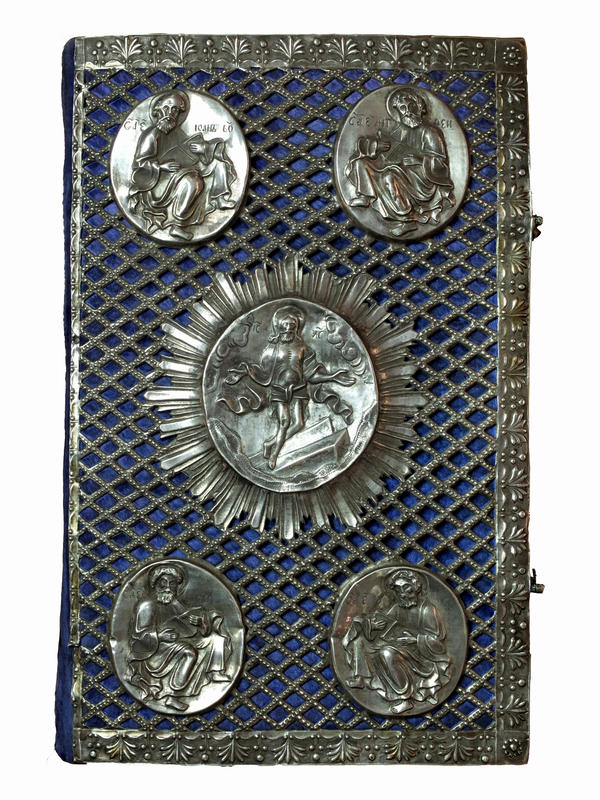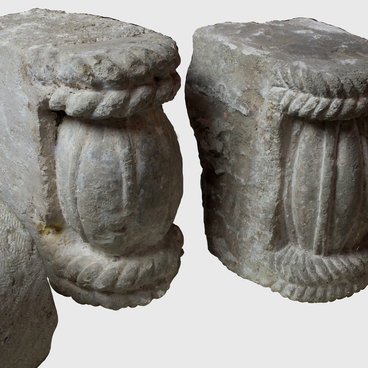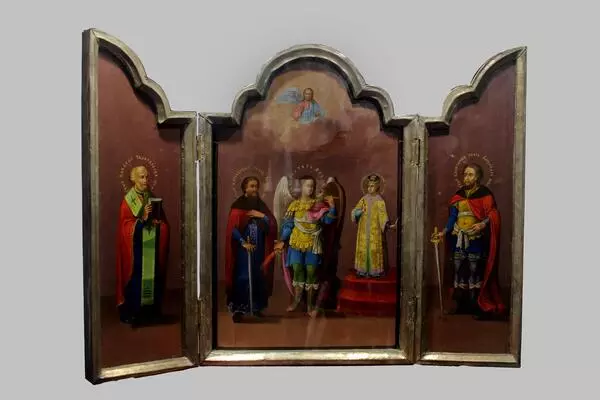In the broad sense of the word, The Gospel means the Good News of advent of the Kingdom of God and Salvation of the Humankind; the News were proclaimed by Christ and his Apostles. In the narrow sense, this is a narrative of the earthly life of Jesus recorded by his closest disciples. The Gospels of Mark, Luke, John and Matthew are deemed canonical. The Gospels are stored on the Communion Table in the Altar, the main part of an Orthodox cathedral.
As the Gospels contain words, teachings and acts of Jesus, they are believed to be personification of Christ. Therefore, in the center of the covers of the Communion-Table Gospels there usually is an episode with the Savior: he can be shown either crucified, or sitting with angels and Evangelists, or rising from the dead.
The Gospel exhibited in the Gallery of the Modern Orthodox Arts was printed in 1757. For its cover, the Uglich silversmith Mikhail Khorkhorin selected the subject of Resurrection of Christ. Russian covers of 14th-17th centuries usually had the Crucifixion of Jesus or his image as the Heavenly King as the central image, while the episode of the Resurrection appeared later. Making this cover in 1809, Khorkhorin was guided by samples of western ecclesiastical art. The inset silver decorative plaque is surrounded with radiancy, while Jesus is depicted as hovering over his tomb.
The cover base is a grid of a diagonal design. Similar to the decorative plaque, it is made of silver. Alongside with gold, in Christianity silver is a symbol of the Divine grace and represents repentance and chastity of the saintly life. The reverse side of the cover shows the Golgotha Cross on which Christ is believed to have been crucified. The corners are decorated with triangle insets with engraved roses.
In the 19th century, members of the merchant family of Khorkhorins headed many icon workshops; their products were purchased not only by local churches and monasteries, but also by other merchants. Some features of the cover indicate that this is an immature work by Khorkhorin: for instance, garments of the Evangelists are split with layers of heavy and excessively tangled folds. Nonetheless, the painting complies with all the canons of Orthodox symbolics.
As the Gospels contain words, teachings and acts of Jesus, they are believed to be personification of Christ. Therefore, in the center of the covers of the Communion-Table Gospels there usually is an episode with the Savior: he can be shown either crucified, or sitting with angels and Evangelists, or rising from the dead.
The Gospel exhibited in the Gallery of the Modern Orthodox Arts was printed in 1757. For its cover, the Uglich silversmith Mikhail Khorkhorin selected the subject of Resurrection of Christ. Russian covers of 14th-17th centuries usually had the Crucifixion of Jesus or his image as the Heavenly King as the central image, while the episode of the Resurrection appeared later. Making this cover in 1809, Khorkhorin was guided by samples of western ecclesiastical art. The inset silver decorative plaque is surrounded with radiancy, while Jesus is depicted as hovering over his tomb.
The cover base is a grid of a diagonal design. Similar to the decorative plaque, it is made of silver. Alongside with gold, in Christianity silver is a symbol of the Divine grace and represents repentance and chastity of the saintly life. The reverse side of the cover shows the Golgotha Cross on which Christ is believed to have been crucified. The corners are decorated with triangle insets with engraved roses.
In the 19th century, members of the merchant family of Khorkhorins headed many icon workshops; their products were purchased not only by local churches and monasteries, but also by other merchants. Some features of the cover indicate that this is an immature work by Khorkhorin: for instance, garments of the Evangelists are split with layers of heavy and excessively tangled folds. Nonetheless, the painting complies with all the canons of Orthodox symbolics.




